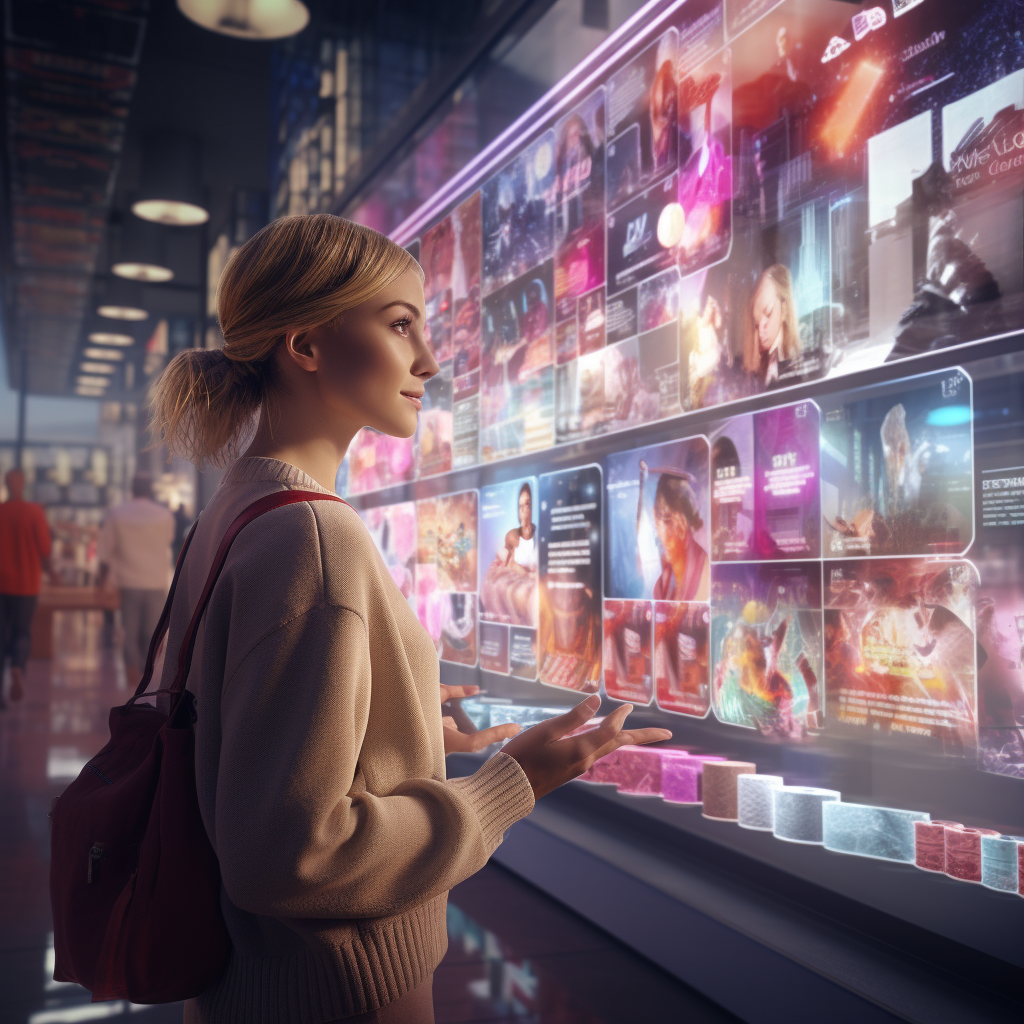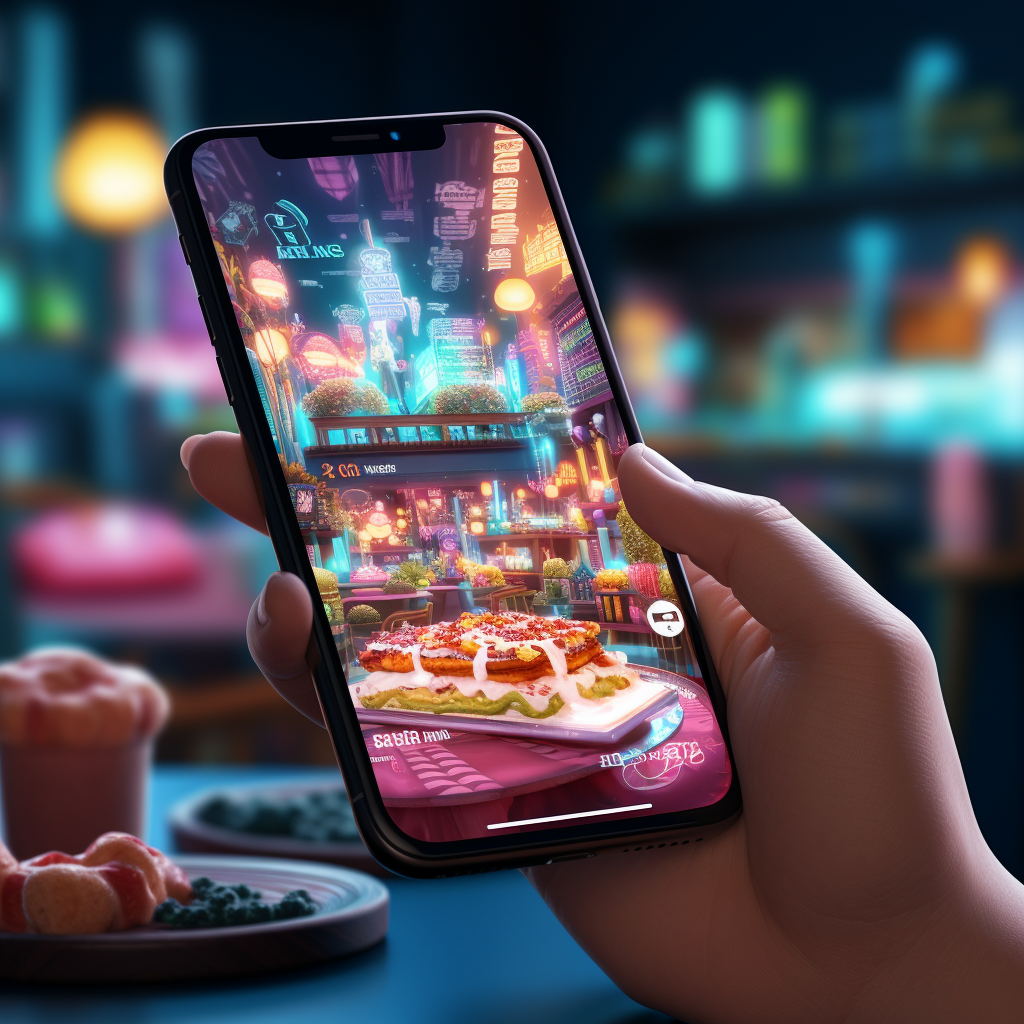Reading Time: 11 minutes

Introduction
In the ever-evolving landscape of digital marketing, staying ahead of the curve is crucial. Today, we dive into two cutting-edge trends that are reshaping the way businesses connect with their audiences: the Metaverse and Gamification. These innovations are not just buzzwords; they are game-changers that have the potential to revolutionize your marketing strategy.
The Metaverse Revolution: What You Need to Know
The Metaverse is no longer science fiction; it’s a tangible digital universe where people interact, work, and play. Imagine a world where reality and the virtual seamlessly blend, offering endless possibilities for businesses. Here are some key insights:
- Metaverse Defined: The Metaverse is a collective virtual shared space, merging augmented reality (AR), virtual reality (VR), and the internet. It’s a space where users can immerse themselves in a digital universe.
- Growing Ecosystem: Companies like Facebook (now Meta), Epic Games, and Microsoft are heavily investing in the Metaverse. Meta alone has committed billions of dollars to create a metaverse that redefines social interactions, work, and entertainment.
- Infinite Opportunities: From virtual showrooms and interactive brand experiences to virtual reality trade shows and social gatherings, the Metaverse offers a vast playground for businesses to engage with customers.
The Power of Gamification in Marketing
- Engagement Boost: Gamification techniques tap into our innate desire for competition, achievement, and reward. By incorporating elements like points, badges, and leaderboards, marketers can make their campaigns more engaging and interactive.
- Learning Through Play: Gamified experiences help customers learn about products or services in a fun and non-intrusive way. From quizzes to interactive simulations, gamification enhances the learning process.
- Data-Driven Insights: Gamification allows for the collection of valuable customer data. Marketers can gain insights into user behavior, preferences, and pain points, which can inform future marketing strategies.
Setting the Stage: The Metaverse Market Size in 2022
Before diving deeper into how gamification and the Metaverse can be combined for marketing success, let’s set the stage by looking at the Metaverse’s market size in 2022:
- Explosive Growth: The Metaverse market has witnessed explosive growth, with a market size estimated at over $250 billion in 2022. This growth is driven by investments in virtual reality, augmented reality, and blockchain technologies.
- Diverse Industries: The Metaverse is not limited to one industry. It spans gaming, entertainment, education, real estate, fashion, and more, making it a versatile platform for marketers to explore.
- Consumer Adoption: Consumer adoption of Metaverse-related technologies is on the rise, with VR headsets becoming more accessible and widespread. This presents a prime opportunity for businesses to engage with their target audiences in novel ways.

Metaverse Marketing Unveiled
As the Metaverse continues to grow and evolve, innovative marketing strategies are essential for staying relevant and competitive. By exploring the advertising opportunities and creating virtual products within the Metaverse, you can establish a strong digital presence and connect with your audience in new and exciting ways.
Beyond Reality: Exploring the Metaverse Advertising Landscape
- Immersive Advertising: Imagine having your audience walk through a virtual store where they can interact with your products or services in a 3D space. Metaverse environments allow for such immersive advertising experiences, making your brand more memorable.
- In-Game Advertising: With gamification being a core component of the Metaverse, in-game advertising opportunities abound. Whether it’s placing your brand within a popular virtual game or creating bespoke in-game experiences, the possibilities are endless.
- Virtual Billboards: Just as in the real world, you can have virtual billboards in the Metaverse. These billboards can display dynamic, interactive content, ensuring that your message stands out in the digital crowd.
- Social VR Ads: Socializing is a significant part of the Metaverse experience. Brands can create social VR ads that enable users to gather in virtual spaces and engage with branded content in a social context.
Metaverse Products: Creating a Virtual Branding Playground
- Virtual Stores: Set up virtual storefronts where customers can browse, try on virtual clothing, test out cosmetics, or explore your product lineup in a virtual environment. This not only enhances the shopping experience but also allows you to gather data on customer preferences.
- Product Launches: Launching a new product in the Metaverse can generate buzz and excitement. Host a virtual launch event complete with interactive demos and giveaways to engage your audience.
- Virtual Brand Ambassadors: Create virtual brand ambassadors or mascots that can interact with customers in the Metaverse. These avatars can represent your brand’s personality and engage users in a more personal and immersive way.
- Metaverse-exclusive Merchandise: Offer limited-edition virtual merchandise or collectibles that users can acquire within the Metaverse. This creates a sense of exclusivity and drives user engagement.
- Interactive Experiences: Develop interactive Metaverse experiences that align with your brand’s values and messaging. Whether it’s a virtual adventure tied to your products or a gamified experience, these interactions create lasting impressions.

Advertising in the Metaverse: A How-To Guide
As you embark on your Metaverse marketing journey, remember that it’s a dynamic and exciting space where imagination knows no bounds. By crafting a well-thought-out strategy, building a meaningful brand presence, and navigating the Metaverse with these tips in mind, you’ll be well on your way to turning marketing into an engaging digital experience that captivates your audience and propels your brand into the future. Stay innovative, stay connected, and let the Metaverse be your canvas for digital success.
Crafting Your Metaverse Marketing Strategy
- Define Your Objectives: Start by clearly outlining your marketing objectives in the Metaverse. Are you looking to increase brand awareness, boost sales, or engage with a specific target audience? Knowing your goals will guide your strategy.
- Audience Research: Understand your Metaverse audience. What platforms are they active on? What are their preferences and behaviors? This information is crucial for tailoring your campaigns.
- Choose the Right Platforms: With various Metaverse platforms emerging, choose the ones that align with your goals and target audience. Platforms like Decentraland, Roblox, and Fortnite offer diverse advertising opportunities.
- Content Creation: Develop creative and immersive content that resonates with the Metaverse audience. Consider 3D advertisements, interactive experiences, or even virtual influencers to capture attention.
- Gamify Your Ads: Since gamification is a powerful tool, incorporate gamified elements into your Metaverse advertising. Gamified ads can boost engagement and encourage user participation.
- Budget Allocation: Allocate a budget specifically for your Metaverse marketing efforts. Keep in mind that Metaverse advertising may require different pricing models, so be prepared for flexibility.
Building Your Brand in the Metaverse
- Virtual Presence: Establish a strong virtual presence by creating a branded space or storefront in the Metaverse. Ensure it reflects your brand’s identity and values.
- Virtual Products: Develop virtual products or experiences that enhance your brand’s presence. These could be anything from virtual fashion collections to branded in-game items.
- Collaborations: Explore collaboration opportunities with other brands, creators, or influencers in the Metaverse. Joint ventures can extend your reach and introduce your brand to new audiences.
- Community Engagement: Actively engage with the Metaverse community. Participate in virtual events, forums, and social spaces to build rapport and foster brand loyalty.
- Feedback Loop: Use the interactive nature of the Metaverse to gather feedback directly from users. This can help refine your products and marketing strategies.
Navigating the Metaverse: Tips for Success
- Stay Updated: The Metaverse landscape is constantly evolving. Stay informed about platform updates, trends, and emerging technologies to remain competitive.
- Experiment: Don’t be afraid to experiment with new ideas and approaches. The Metaverse is a creative playground, and innovation can set you apart from the competition.
- User Privacy: Respect user privacy and data security. Ensure that your Metaverse marketing complies with relevant regulations and standards.
- Measure and Analyze: Implement analytics tools to track the performance of your Metaverse campaigns. Use data-driven insights to optimize your strategy over time.
- Be Authentic: Authenticity is key in the Metaverse. Ensure that your brand’s values and messaging align with the immersive experiences you create.

The Metaverse Market Size: Trends and Projections
Businesses that understand and embrace the Metaverse now are positioning themselves for a future where the boundaries between reality and the virtual world blur. As we move forward, it’s essential to stay informed about the latest developments and seize the opportunities that the Metaverse presents for marketing and beyond.
A Glimpse into the Metaverse Market Size in 2022
- Market Valuation: In 2022, the Metaverse market surpassed the $250 billion mark, marking a substantial increase from previous years. This growth was driven by investments from tech giants like Meta (formerly Facebook), Epic Games, and Microsoft, who recognize the transformative potential of the Metaverse.
- Diverse Industries: The Metaverse is a dynamic ecosystem that spans various industries, including gaming, entertainment, education, real estate, fashion, and more. This diversification reflects the adaptability of the Metaverse concept to virtually any field.
- Consumer Adoption: Consumer adoption of Metaverse-related technologies saw a significant uptick in 2022. The availability of more affordable VR headsets and the proliferation of immersive experiences contributed to this trend. As a result, more individuals are engaging with the Metaverse on a regular basis.
Growth Potential: Where the Metaverse Market is Heading
- Economic Impact: Experts project that by 2030, the Metaverse could have an economic impact exceeding $1 trillion. This staggering figure underscores the Metaverse’s potential to reshape economies and industries worldwide.
- Work and Collaboration: The Metaverse is poised to revolutionize how we work and collaborate. Virtual offices, remote teamwork, and immersive meetings are just the beginning. As businesses seek more efficient and engaging ways to operate, the Metaverse will play a central role.
- Education and Training: The Metaverse offers unparalleled opportunities for education and training. From virtual classrooms and immersive simulations to hands-on skill development, it’s set to transform the way we learn.
- Entertainment and Social Interaction: Gaming, entertainment, and social interaction will remain driving forces in the Metaverse. Expect to see the emergence of new forms of entertainment, interactive social spaces, and virtual events on a grand scale.
- Blockchain Integration: Blockchain technology will play a pivotal role in the Metaverse, enabling secure transactions, digital ownership, and decentralized governance. NFTs (Non-Fungible Tokens) will continue to gain prominence as digital assets within the Metaverse.
- Regulatory Challenges: As the Metaverse expands, it will face regulatory challenges related to privacy, security, and intellectual property rights. Navigating these issues will be crucial for its sustainable growth.
- Technological Advancements: Continued advancements in AR, VR, and AI technologies will enhance the Metaverse’s capabilities, making it even more immersive and accessible.
- Cross-Platform Integration: Interoperability between different Metaverse platforms will become increasingly important, allowing users to move seamlessly between virtual worlds.

Metaverse and Gamification: The Perfect Blend
As we’ve journeyed through the Metaverse and explored the exciting possibilities it offers for marketing, it’s time to examine how gamification seamlessly integrates with this digital universe. In this section, we’ll uncover the power of combining the Metaverse with gamification, analyze its advantages over traditional marketing, and explore real-world success stories.
Harnessing Gamification for Metaverse Marketing
- Engagement Amplified: Gamification in the Metaverse amplifies user engagement to unprecedented levels. The interactive nature of virtual environments encourages users to participate actively in brand experiences, fostering a deeper connection.
- Rewarding Interactions: Gamification allows you to reward users for specific actions, such as exploring your virtual space, completing challenges, or interacting with your products. These rewards can range from virtual items and currency to exclusive access and recognition.
- Learning and Exploration: In the Metaverse, gamification serves as a powerful tool for education and exploration. Brands can create immersive experiences that educate users about their products or services while keeping them entertained.
- Data-Driven Insights: Gamified Metaverse campaigns provide valuable data insights. Marketers can track user behavior, preferences, and performance metrics, enabling data-driven optimization of future campaigns.
- Community Building: Gamification fosters a sense of community within the Metaverse. Users can collaborate, compete, and communicate, creating a vibrant ecosystem around your brand.
Metaverse vs. Traditional Marketing: A Comparative Analysis
- Interactivity: In the Metaverse, interactivity is central. Traditional marketing methods often lack the immersive, two-way interaction that the Metaverse offers.
- Immersive Experiences: The Metaverse provides a platform for fully immersive brand experiences, while traditional marketing relies on static advertisements and messages.
- Data Collection: Metaverse campaigns offer more extensive data collection opportunities, allowing for precise targeting and personalization. Traditional marketing may struggle to gather such detailed insights.
- Global Reach: The Metaverse transcends geographical boundaries, offering a global reach that traditional marketing channels may struggle to achieve.
- Scalability: Virtual experiences can be scaled more easily than physical ones, making the Metaverse a cost-effective option for reaching a vast audience.
Real-world Gamification Success Stories
- McDonald’s Monopoly Game: McDonald’s Monopoly game is a classic example of real-world gamification. Customers collect game pieces from their food and have the chance to win various prizes, creating excitement and customer loyalty.
- Nike+ Running App: Nike+ turned running into a game with their app. Users can set goals, track their runs, and compete with friends. This gamified approach not only promotes fitness but also enhances the Nike brand experience.
- Duolingo: Duolingo gamified language learning by incorporating points, streaks, and leaderboards. Users are motivated to keep learning by earning rewards and competing with others.
- Starbucks Rewards: Starbucks’ loyalty program is gamified through their mobile app. Customers earn stars for each purchase, working towards free drinks and other perks. This gamified system encourages repeat visits and brand loyalty.
- Sephora Beauty Insider: Sephora’s Beauty Insider program rewards customers with points and exclusive offers. It encourages customers to engage with the brand, try new products, and share their experiences.

What Lies Ahead: The Future of Metaverse Marketing
As we approach the conclusion of our journey through the Metaverse and the world of gamification in marketing, it’s time to turn our gaze to the future. In this section, we’ll peer into the crystal ball of speculation, exploring predictions and emerging trends in Metaverse marketing, and examining the evolving landscape of the Metaverse ecosystem.
Predictions and Speculations for Metaverse Marketing
- Metaverse-First Strategies: In the future, businesses will develop Metaverse-first marketing strategies, prioritizing immersive brand experiences over traditional advertising channels. The Metaverse will become a primary touchpoint for customer engagement.
- Metaverse Search Engines: As the Metaverse expands, specialized search engines will emerge to help users navigate its vast digital landscape. Optimizing for these Metaverse search engines will be a crucial aspect of marketing.
- AI-Driven Personalization: Artificial intelligence will play a central role in Metaverse marketing, delivering personalized experiences tailored to individual preferences and behavior in real-time.
- Metaverse Marketplaces: Specialized Metaverse marketplaces will emerge, where brands can buy, sell, and trade virtual assets, further blurring the lines between virtual and physical commerce.
- Brand Metaverses: Forward-thinking brands will create their own Metaverse environments, offering immersive brand worlds where customers can explore, interact, and shop.
Emerging Trends in Metaverse Advertising
- Augmented Reality (AR) Integration: AR will become an integral part of Metaverse advertising, allowing users to overlay digital information onto their physical surroundings.
- Dynamic Advertising: Ads in the Metaverse will be dynamic and context-aware, changing in response to user behavior and real-world events.
- Social VR Shopping: Virtual reality shopping experiences will become more social, allowing friends and family to shop together in immersive digital malls.
- NFT Marketing: Non-Fungible Tokens (NFTs) will play a more prominent role in Metaverse advertising, offering unique and collectible virtual assets as promotional tools.
- Metaverse Influencers: Virtual influencers and avatars will rise to prominence, collaborating with brands to promote products and services within the Metaverse.
The Metaverse Ecosystem: An Evolving Landscape
- Interoperability: Interoperability between different Metaverse platforms will increase, enabling users to carry their digital identities and assets across virtual worlds seamlessly.
- Regulation and Governance: Governments and regulatory bodies will grapple with the complexities of Metaverse governance, leading to the development of legal frameworks and standards.
- Privacy and Security: Ensuring user privacy and security within the Metaverse will be a pressing concern, prompting innovations in encryption, authentication, and digital identity management.
- Metaverse Economies: Virtual economies within the Metaverse will continue to grow, with users earning and spending virtual currency on a wide range of goods and services.
- Emergence of New Metaverses: New Metaverse platforms and ecosystems will continue to emerge, each catering to different niches and user preferences.

Conclusion
Our exploration of the Metaverse and gamification in marketing has been a thrilling journey through the future of digital engagement. As we conclude this comprehensive guide, let’s recap the key takeaways and insights that can inspire your marketing strategies in the ever-evolving world of the Metaverse.
Bridging the Gap: Marketing in the Metaverse and Gamification
- Engagement Powerhouse: Gamification enhances user engagement in the Metaverse by tapping into our natural desire for competition and reward. It makes marketing more interactive, memorable, and enjoyable.
- Immersive Experiences: The Metaverse offers a canvas for creating immersive brand experiences, and gamification adds layers of interactivity, challenge, and fun to those experiences.
- Data-Driven Insights: Both the Metaverse and gamification provide valuable data insights that can inform future marketing strategies. Together, they create a data-rich environment for optimization and personalization.
The Shareworthy Metaverse: Inspiring Digital Experiences
- Imagination Knows No Bounds: The Metaverse is a realm of unlimited creativity. Let your brand’s imagination soar and create experiences that surprise, delight, and inspire awe.
- User-Centric Design: Place the user at the center of your Metaverse experiences. Tailor your campaigns to their preferences, and ensure they have agency within your virtual spaces.
- Storytelling Matters: Craft compelling narratives that draw users into your brand’s world. Engage them emotionally, and they’ll be more likely to share their experiences.
- Community Building: Foster communities within the Metaverse that revolve around your brand. These communities can become loyal advocates and amplify your marketing efforts.
Embrace the Metaverse: Future-Proofing Your Marketing Strategies
- Early Adoption Advantage: By getting in early, you can establish a strong digital presence in the Metaverse and gain a competitive edge.
- Adaptability: Be ready to adapt and iterate as the Metaverse evolves. Stay agile and open to emerging trends and technologies.
- Data-Driven Decision-Making: Leverage the data-rich environment of the Metaverse to make informed marketing decisions and refine your strategies.
- Invest in Education: Invest in educating your marketing team about the Metaverse. The more you understand its nuances, the more effectively you can leverage it.


